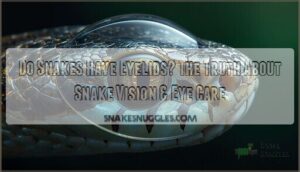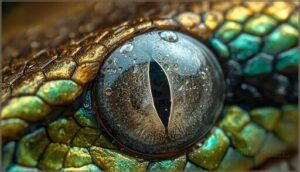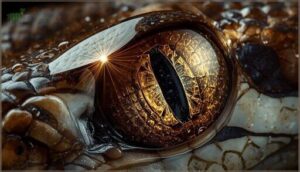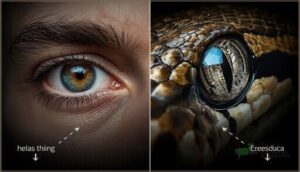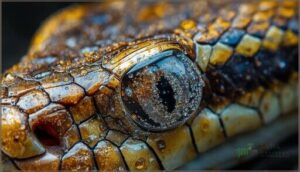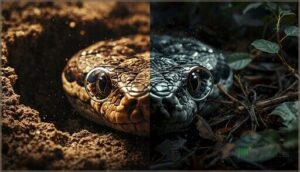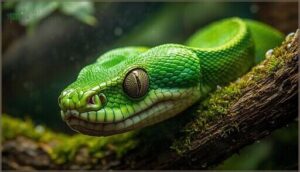This site is supported by our readers. We may earn a commission, at no cost to you, if you purchase through links.
Look closely at a snake’s unblinking stare, and you might assume it’s locked in concentration or poised to strike. The reality is simpler: snakes can’t blink because they don’t have eyelids. Instead of movable lids, these reptiles possess a transparent scale called a brille, or spectacle, that permanently covers and protects each eye.
This specialized structure shields the eye from debris while maintaining optical clarity, a clever evolutionary trade-off that suits their unique lifestyle. Understanding how this system works reveals fascinating anatomy but also essential knowledge for anyone who keeps snakes as pets, since the brille depends entirely on proper shedding cycles to stay clean and functional.
Table Of Contents
- Key Takeaways
- Do Snakes Have Eyelids?
- What Protects Snake Eyes Instead of Eyelids?
- How Do Snakes Keep Their Eyes Clean?
- How Do Snakes Sleep Without Eyelids?
- How Does Snake Vision Work?
- Why Did Snakes Evolve Without Eyelids?
- How to Maintain Snake Eye Health
- Frequently Asked Questions (FAQs)
- Why do snakes lack eyelids?
- Do snakes have eyelids?
- Do snakes sleep with their eyes open?
- Do snakes have eye scales?
- What do snake eyes look like?
- Do snakes have eye problems?
- Do snakes have any other eye protection mechanisms?
- What is the hearing range for snakes?
- How do snakes use their tongue and sense of smell?
- What types of locomotion do snakes use?
- Conclusion
Key Takeaways
- Snakes don’t have movable eyelids—instead, they’ve evolved a transparent scale called a brille (or spectacle) that permanently covers each eye, providing constant protection while allowing continuous vision.
- The brille sheds along with the rest of the snake’s skin during ecdysis, making proper humidity levels (40-60% baseline, 60-80% during shedding) critical to prevent retained spectacles that can lead to vision impairment and infections.
- Without blinking mechanisms to clean their eyes, snakes rely entirely on the shedding cycle to remove debris, meaning incomplete sheds pose serious risks requiring immediate veterinary attention if home remedies fail within 24-48 hours.
- Snakes sleep with their eyes permanently open because the brille can’t close, but they achieve rest through neural gating—their brains actively downregulate retinal signals and narrow pupils to reduce visual input during 16-20 hour daily rest periods.
Do Snakes Have Eyelids?
Have you ever looked into a snake’s eyes and wondered why they seem to stare endlessly without blinking? Here’s the truth: snakes don’t have movable eyelids like you do. Instead of upper and lower lids that open and close, every modern snake species has evolved with a completely different solution.
During embryonic development, their eyelids fuse together permanently, forming a transparent covering that never moves. This fused structure, called a brille or spectacle, is actually a modified ocular scale that stays sealed over each eye from the moment they hatch.
Without functional blinking mechanisms, snakes can’t actively close their eyes to block light or debris. This basic difference in snake anatomy sets them apart from most other vertebrates and plays a significant role in their visual system and ocular protection strategy.
Sometimes, this spectacle can be subject to retention, often due to improper shedding.
What Protects Snake Eyes Instead of Eyelids?
Since snakes don’t have traditional eyelids, you might wonder what keeps their eyes safe from dirt, debris, and injury. Nature gave them a specialized protective layer that stays in place all the time.
Let’s look at how this unique eye covering works, what it’s made of, and why it’s different from the eyelids you’re used to seeing in other animals.
The Brille (Spectacle) Structure
Think of the brille as a biological contact lens that snakes are born with. This transparent ocular scale forms when a snake’s upper and lower eyelids fuse during embryonic development, creating a fixed spectacle instead of movable lids.
The brille’s layered microanatomy includes three distinct zones: an outer epithelium with alternating keratin strata, a collagenous middle layer, and an inner conjunctival surface facing a fluid-filled chamber. This spectacle helps with tear retention to keep the eye moist.
How The Brille Functions
The brille’s optical properties let light pass through with minimal distortion, thanks to its high refractive index of around 1.5. These layered spectacles maintain structural integrity while protecting your snake’s cornea from debris.
The brille also manages moisture retention by trapping fluid between itself and the eye surface. During the snake shedding process, secretions from glands lubricate the spectacle, keeping snake eye anatomy healthy between molts.
Differences From Traditional Eyelids
Unlike traditional eyelids that blink 10–20 times per minute using orbicularis muscles, your snake’s spectacle stays completely immobile—no muscles, no movement.
Eyelids close for protection and spread tears across the cornea with each blink, but the brille creates a sealed subspectacular space where lacrimal fluid circulates continuously and drains through a nasolacrimal duct into the oral cavity instead.
How Do Snakes Keep Their Eyes Clean?
Without eyelids to wipe away dirt and debris, you might wonder how snakes keep their eyes clean and healthy. The answer lies in their natural shedding cycle, which removes dust and particles that accumulate on the brille over time.
However, this process doesn’t always go smoothly, and snakes face unique risks regarding eye care.
Shedding Process and Eye Health
When your snake outgrows its skin, the shedding process—called ecdysis—removes the brille along with the old skin, renewing eye health every time. This generally happens multiple times yearly, depending on species and conditions.
During shedding:
- The spectacle clouds over as a new layer forms underneath
- Blood vessels stay active to support the renewal process
- Complete one-piece head sheds confirm healthy snake eye health
- Low humidity increases retained spectacles and infection risks
- Proper shedding frequency prevents vision-threatening complications
Preventing and Managing Retained Brille
To stop retained spectacles from ruining your snake’s vision, consistent humidity and shedding aids are essential. When home remedies like lukewarm soaks and ophthalmic gel fail after a few days, veterinary care becomes necessary. Removing old brille incorrectly can cause permanent corneal damage. Prevention is key, as multiple layers of retained spectacles increase the risk of serious infections and vision loss.
| Prevention Strategy | What to Do | Why It Matters |
|---|---|---|
| Humidity Control | Maintain 40–60% baseline, raise to 60–70% during blue phase | Prevents incomplete sheds and stuck eye caps |
| Shedding Aids | Provide humid hide, rough branches, soaking bowl | Supports mechanical spectacle removal |
| Veterinary Care | Seek help if retained brille persists 24–48 hours | Avoids corneal exposure and permanent damage |
Risks of Eye Infections in Snakes
Without movable eyelids, your snake faces constant exposure to pathogens that cause eye infections. Spectacle disorders dominate veterinary cases, with retained brille and subspectacular abscesses topping the list.
Pseudomonas aeruginosa infects over 58% of captive snakes, and multidrug-resistant strains complicate treatment.
Poor husbandry—low humidity, dirty enclosures—drives infection prevalence and vision problems, turning minor snake eye care lapses into serious snake health problems requiring surgical intervention.
How Do Snakes Sleep Without Eyelids?
You might wonder how snakes manage to rest when their eyes stay open all the time. The truth is, they’ve developed a clever workaround that doesn’t involve closing their eyes like we do.
Let’s look at how snakes actually sleep, what happens inside their eyes during rest, and clear up some common misunderstandings about snake sleep habits.
Snake Sleep Patterns and Behavior
You might picture a snake resting for just a few hours, but captive snakes actually sleep or stay inactive for about 16–20 hours daily, with nocturnal species like ball pythons reaching 20–23 hours between meals.
Circadian rhythms vary by species—some hunt at dawn, others at night. EEG studies reveal slow-wave sleep phases in snakes, though environmental factors like temperature and hiding spots strongly influence these sleeping habits and periods of brumation-like dormancy.
Retinal Closure Vs. Eyelid Closure
You know how closing your eyes cuts off light? Snakes skip that entirely. Their transparent brille (spectacle) keeps their eyes continuously exposed, yet they still rest through neural gating.
Their brain actively downregulates retinal signals during sleep rather than blocking light mechanically. Pupil modulation helps, narrowing light intake slightly, but true “shutdown” happens in the brain, not at the eye surface. It’s retinal downregulation, not physical closure.
Snakes rest not by closing their eyes, but by dimming vision in their brains while their pupils narrow slightly
Myths About Snake Sleep
Ever heard that snakes never truly rest? That’s one of the most stubborn common myths about snakes. Their eyes stay always open, yet research reveals surprising truths about snake sleeping habits:
- Sleep duration rivals yours – African rock pythons log 16-plus hours daily, not constant wakefulness.
- Brain activity shifts – They’re not fully aware; reduced responsiveness replaces vigilance.
- Post-meal drowsiness – Sleep exceeds 20 hours after feeding, debunking little sleep claims.
- No mammalian sleep stages – Snake spectacles don’t mean mammal-like REM cycles exist.
How Does Snake Vision Work?
You might assume that snakes see the world like we do, but their visual system works quite differently. Without eyelids to blink away distractions, they’ve developed specialized ways to track movement, sense light changes, and even detect heat signatures from potential prey.
Let’s look at the key adaptations that make snake vision so effective.
Advanced Vision and Sensory Systems
Although you might assume snakes rely on basic vision alone, their eyes represent an elaborate toolkit shaped by evolution. Snake vision varies dramatically across species, driven by opsin diversity—genetic variations in light-detecting proteins. Some snakes retain three visual opsins for dichromatic color vision, while certain sea snakes have regained up to four cone types. Beyond visible light, many species detect UV coloration invisible to humans, and pit-bearing snakes add infrared perception to their arsenal.
Retinal structure shifts with lifestyle: nocturnal species pack more rods for low-light hunting, while diurnal snakes boost cone density for sharper daytime acuity. This multisensory integration—combining visual, thermal, and chemical cues—transforms snake eyes into precise predatory instruments. Understanding these snake adaptations reveals why motion detection and heat vision make snakes such effective hunters.
| Visual Feature | Nocturnal Snakes | Diurnal Snakes |
|---|---|---|
| Dominant Photoreceptors | Rod-rich retinas | Cone-dense retinas |
| Color Sensitivity | Limited; optimized for dim light | Enhanced; UV-sensitive opsins common |
| Special Adaptations | Elongated outer segments for photon capture | Thicker retinal layers for visual acuity |
Motion Detection and Light Sensitivity
Your pet snake’s eye structure isn’t just for show—it’s engineered for motion detection and light sensitivity. Temporal resolution differs across species: diurnal snakes have cone-dominated retinas that catch fast movements in bright conditions, while nocturnal types sacrifice speed for sensitivity.
Spectral tuning adjusts which wavelengths each species detects best, and central pathways in the optic tectum process these visual cues. Environmental modulation fine-tunes this system, optimizing snake vision for hunting across habitats.
Heat-Sensing Adaptations
Beyond visible light, pit vipers, pythons, and boas possess facial pit organs—small cavities between nostril and eye—that detect infrared radiation from warm-blooded prey.
These thermoreception chambers use TRPA1 ion channels to sense temperature differences as tiny as 0.003°C, feeding thermal imaging data into the optic tectum alongside visual input.
This heatsensing system guides strikes in darkness and inspires bioinspired technologies like uncooled sensor arrays.
Why Did Snakes Evolve Without Eyelids?
Evolution doesn’t make random choices, and the brille didn’t replace eyelids by accident. Snakes developed this unique eye protection because their lifestyle on and beneath the ground demanded constant vigilance and defense against debris.
Let’s look at the specific evolutionary pressures that shaped this noteworthy adaptation.
Evolutionary Advantages of The Brille
The brille emerged as a survival advantage in early fossorial snakes, providing continuous abrasion resistance against soil particles and debris. This evolutionary adaptation offers you four key benefits that traditional eyelids can’t match:
- Constant protection – The spectacle shields your snake’s eyes 24/7 without blinking interruptions
- Optical transparency – High light transmission preserves visual acuity despite the protective barrier
- Vascular regulation – Blood vessels constrict during threats, maintaining clarity when vision matters most
- Structural durability – Thickness varies by species, with burrowing snakes developing thicker spectacles for enhanced mechanical protection
This snake anatomy innovation balances protection with performance.
Environmental Adaptations
Different habitats shaped how thick a snake’s spectacle grew and how large its eyes became. Fossorial and aquatic species developed considerably thicker spectacles—ranging from 74 to 244 micrometers—than arboreal snakes, protecting against abrasion and pressure. Meanwhile, terrestrial snakes evolved larger eye size to capture more light in open environments, while subterranean species reduced ocular structures, prioritizing ocular health over vision in dim, debris-filled burrows.
| Habitat Type | Spectacle Thickness | Eye Size Adaptation |
|---|---|---|
| Fossorial (burrowing) | Thickest (up to 244 μm) | Reduced, smaller eyes |
| Aquatic/Semi-aquatic | Thick to moderate | Moderate to large |
| Terrestrial | Thinner | Largest relative size |
| Arboreal (tree-dwelling) | Thinnest | Moderate size |
| Subterranean | Very thick protective layers | Substantially reduced |
Comparison With Other Reptiles
Unlike snakes, most reptiles kept the eyelids their ancestors had. Lizards blink to clean their corneas and distribute tear film, while turtles use both eyelids and a nictitating membrane for eye protection. However, some geckos and amphisbaenians evolved spectacles independently, showing that reptile eye adaptations can follow similar paths in different lineages when facing comparable environmental challenges.
- Lizards: Most possess movable upper and lower eyelids plus a nictitating membrane
- Turtles: Retain mobile eyelids for mechanical protection and tear distribution
- Geckos: Many species developed fixed spectacles like snakes
- Amphisbaenians: Share the spectacle condition, indicating convergent evolution
How to Maintain Snake Eye Health
If you keep a snake as a pet, protecting its eyes becomes your responsibility. Your snake can’t blink away irritants or wipe its spectacles clean, so you need to create the right environment and watch for warning signs.
Here’s what you should focus on to keep your snake’s eyes healthy and clear.
Importance of Proper Humidity and Shedding
Your snake’s eye health hinges on proper humidity—think of it as moisture insurance for successful shedding. Most species need a 40–60% baseline humidity, but you’ll want to bump that up to 70–80% during active shedding to prevent retained spectacles.
Low humidity is the leading cause of stuck eye caps, which can stack up over multiple sheds and threaten vision.
Monitor humidity carefully using digital hygrometers, and consider creating humid microclimate zones with damp moss hides so your snake can self-regulate moisture exposure during ecdysis.
Cleaning and Eye Care for Pet Snakes
You don’t need fancy equipment to protect your pet snake’s eye health—just consistent attention to enclosure hygiene and routine cleaning. Weekly disinfection of the habitat reduces bacterial load by 90%, while fresh water daily prevents opportunistic pathogens.
When retained spectacles occur despite proper humidity, lukewarm saline baths soften stuck caps safely. For persistent issues or eye infections, veterinary treatment combined with nutritional support ensures complete recovery.
Recognizing and Preventing Eye Problems
Cloudy eyes outside pre-shed periods signal trouble—retained spectacles lead to vision impairment if ignored. Early detection through weekly visual checks prevents ocular infections before they escalate.
Husbandry risks like low humidity cause most eye problems, making preventative care essential. Schedule veterinary checkups annually to catch subclinical issues.
Proper snake care means monitoring every shed’s completeness, because missing eyecaps warn of retained spectacles requiring immediate attention to preserve your snake’s eye health.
Frequently Asked Questions (FAQs)
Why do snakes lack eyelids?
Fossorial origins shaped their anatomy. Early snakes burrowed underground, where movable eyelids couldn’t protect against abrasive soil.
The fused spectacle—or brille—provided continuous vision and constant protection, offering evolutionary advantages their lizard-like ancestors lacked.
Do snakes have eyelids?
No, snakes don’t have movable eyelids. Instead, a transparent scale called the brille or spectacle covers each eye, providing constant protection while enabling continuous snake vision across all 3,600 species worldwide.
Do snakes sleep with their eyes open?
Yes, you’ll always see snake eyes looking right at you even when they’re fast asleep. Their brille keeps eyes permanently open, but retinal mechanisms and rest cycles shut down visual processing during extended immobility periods.
Do snakes have eye scales?
Unlike other reptiles with ordinary scales covering their bodies, every snake eye structure features a unique transparent eye cap called the brille or spectacle—a specialized scale fused from embryonic eyelids providing constant protection.
What do snake eyes look like?
You’ll notice snake eyes have a glossy appearance due to the transparent brille covering them.
Pupil shapes vary—round, vertical slits, or horizontal—while eye size and coloration patterns differ across species.
Do snakes have eye problems?
Opaque, bulging scales and clouded vision signal trouble. Pet snakes often face retained spectacles from poor humidity, while bacterial or fungal subspectacular abscesses cause serious ocular infections requiring veterinary intervention to prevent vision impairment.
Do snakes have any other eye protection mechanisms?
Beyond the brille, snakes maintain a tear film in the subspectacular space that provides continuous hydration and flushes debris.
This fluid drains via the lacrimal duct, offering infection mitigation and supporting optical functions during ecdysis protection.
What is the hearing range for snakes?
Snakes detect airborne sounds primarily between 80 and 1,000 Hz, with peak frequency sensitivity around 80–160 Hz.
Substrate vibration enhances auditory processing at low frequencies, though species variation affects behavioral responses across different sound ranges.
How do snakes use their tongue and sense of smell?
Your snake’s forked tongue flicks rapidly to collect chemical cues from the air and ground, delivering them to Jacobson’s organ in the mouth—enabling directional chemoreception that helps track prey and detect pheromones.
What types of locomotion do snakes use?
Four major movement patterns define how your snake travels: lateral undulation for speed, concertina movement in tight spaces, sidewinding across loose surfaces, and aquatic locomotion through water, each with distinct energetic costs and mechanics.
Conclusion
A single retained brille can spiral into a world of trouble, from clouded vision to serious infection. Now that you understand snakes don’t have eyelids—relying instead on transparent scales renewed with each shed—you can spot problems early and maintain peak eye health for your snake.
Monitor humidity levels, watch for incomplete sheds, and recognize warning signs like cloudiness or swelling. Your attention to these details keeps those unblinking eyes clear, protected, and functioning exactly as evolution intended.
- https://en.wikipedia.org/wiki/Ocular_scales
- https://journals.biologists.com/jeb/article/216/22/4190/11762/Blood-flow-dynamics-in-the-snake-spectacle
- https://pmc.ncbi.nlm.nih.gov/articles/PMC10044692/
- https://cordis.europa.eu/article/id/436488-why-can-t-snakes-blink
- https://reptilesdoc.com/do-snakes-blink/

